Relationship between saxophone and natural frequencies
サックスのネックにあるノーマルの止めネジを![]()

★マウスピースの振動を抑えると音が大きくなる
サックスを楽しく演奏できるように吹き方や手入れ方法などお伝えします。
Relationship between saxophone and natural frequencies
サックスのネックにあるノーマルの止めネジを![]()
What happens with what not to do with saxophones.
現在一般的に思われているサックスのマウスピースからの振動を「減らす」事で起こる事柄は、いくつか解釈ができます。それぞれの解釈で音への影響が変わってきます。
What is currently commonly thought to happen by “reducing” the vibration from the saxophone mouthpiece can be interpreted in several ways. Each interpretation will have a different effect on the sound.
考えられる解釈と音への影響は以下の通りです。
* リードの振動を抑制する(噛みすぎ、締め付けすぎなど)
* 音の変化: 音が詰まったようになり、響きが失われ、薄っぺらい、または「ベーベー」とした音になります。音量も小さくなり、音程も不安定になることがあります。リードが効率よく振動できず、本来の音色が出せなくなります。
* 原因: アンブシュア(口の形や使い方)でリードを強く噛みすぎている、リガチャー(リードをマウスピースに固定する金具)を締め付けすぎているなどが考えられます。特に下唇を噛みすぎると、リードとマウスピースの間が狭くなり、リードの振動が妨げられます。
* マウスピースの振動が楽器本体に伝わりにくくなる
* 音の変化: 全体的な響きが損なわれ、音がこもったように聞こえる可能性があります。
* 音色の変化: 本来持つ豊かな倍音が失われ、響きのない、詰まったような音色になってしまいます。サックスはマウスピース、リード、ネック、管体が一体となって振動することで豊かな音色を生み出します。マウスピースからの振動がうまく伝わらないと、楽器全体の共鳴が弱まります。
* 原因: マウスピースとネックの接合部分が緩い、ジョイントコルクが劣化しているなどが考えられます。
* 音の立ち上がりが遅くなる/反応が悪くなる
* 音の変化: 音の出だしが不明瞭になったり、音がぼやけたりします。特に速いフレーズや短い音符で顕著になります。
* 原因: リードが適切に振動しないこと、またはマウスピースのセッティングが合っていないことなどが考えられます。例えば、柔らかすぎるリードを使っている場合、振動はしやすいものの、音の輪郭がぼやけがちになります。
Possible interpretations and effects on sound include
* Suppression of reed vibration (e.g., overbite, over-tightening)
* Changes in sound: The sound becomes choked, loses resonance, and becomes thin or “bassy”. The volume may also decrease and the pitch may become unstable. The reeds will not vibrate efficiently and will not produce their true tone.
* Causes: You may be biting the reed too hard in your embouchure (mouth shape and usage), or you may be tightening the ligature (metal fittings that hold the reed to the mouthpiece) too much. Biting too hard, especially on the lower lip, narrows the space between the reed and mouthpiece and prevents the reed from vibrating.
* Mouthpiece vibration is less likely to be transmitted to the body of the instrument.
* Tone changes: The saxophone loses its inherent rich overtones, resulting in a choked tone with no resonance. The saxophone produces a rich tone by vibrating the mouthpiece, reed, neck, and wind body in unison. If the vibrations from the mouthpiece are not transmitted properly, the resonance of the entire instrument is weakened.
* Cause: The joint between the mouthpiece and neck may be loose, or the joint cork may have deteriorated.
* Slow rise/response of the sound
* Change in sound: The beginning of the note becomes indistinct or blurred. This is especially noticeable in fast phrases or short notes.
* Possible causes: reed not vibrating properly, or mouthpiece not set properly. For example, if you use a reed that is too soft, it will vibrate easily, but the sound will tend to have a blurred outline.
まとめると、サックスのマウスピースからの振動を吸収することで、以下のようなネガティブな影響が出やすいです。
* 音色の劣化: 薄っぺらい、詰まった、響きのない音になる。
* 音量の低下: 音が小さくなる。
* 音程の不安定さ: 音程がブレやすくなる。
* 演奏性の悪化: 音が出しにくくなる、コントロールが難しくなる。
* 結論として音の響きを損なうため、
サックスで良い音を出すためには、リードが自由に、そして効率的に振動できる状態を保つことが非常に重要です。アンブシュア、リード、リガチャー、マウスピース、そしてそれらの組み合わせが全て、リードの振動に大きく影響を与えます。
In summary, vibrations from the saxophone mouthpiece are likely to have the following negative effects due to the inhibition of vibrations.
* Deterioration of tone: the sound becomes thin, choked, and resonant.
* Volume degradation: the sound becomes quieter.
* Insecurity of pitch: The pitch tends to be unsteady.
* Deterioration of playability: harder to produce and control.
* In conclusion, it is not suitable for saxophone playing because it impairs the sound.
To produce a good sound on the saxophone, it is very important to keep the reed vibrating freely and efficiently. The embouchure, reed, ligature, mouthpiece, and their combination all have a significant effect on reed vibration.
また、Google Gemini AIにこの件を聞いたところ 返事は
「振動を制する」と書く「制振材(せいしんざい)」や「減衰材(
これまでお話してきた内容の最終的なまとめとして、
1. 質量が増加するため
制振材や減衰材をマウスピースやリードにつけると、
2. 振動エネルギーが吸収されるため
制振材や減衰材の最大の役割は、
この大切なエネルギーが制振材に吸収されてしまうと、
* 音量の低下: 楽器全体に伝わるエネルギーが減るため、
* 音色の変化: 本来持つ豊かな倍音が失われ、響きのない、
結論として、制振材は固有振動数を低下させると同時に、
Also, when I asked Google Gemini AI about this matter, the response was
When applying vibration-damping materials or damping materials to the vibrating parts of a saxophone mouthpiece, the natural frequency decreases.
As a final summary of the points discussed so far, let me reiterate the two reasons leading to this conclusion.
1. Increased mass
Attaching vibration-damping or damping materials to the mouthpiece or reed increases the overall mass of that section. According to the laws of physics, a larger mass results in a lower natural frequency. Consequently, the pitch of the sound produced by the saxophone also becomes lower.
2. Vibrational energy is absorbed
The primary function of damping materials is to convert vibrational energy into heat or other forms and dissipate it. The sound of the saxophone is produced when the vibrational energy of the reed is amplified through resonance.
When this vital energy is absorbed by the damping material, the following disadvantages occur:
* Decreased volume: Less energy is transmitted throughout the instrument, making it harder to produce loud sounds.
* Change in tone: The instrument’s inherent rich overtones are lost, resulting in a dull, muffled sound lacking resonance.
In conclusion, vibration damping materials are considered unsuitable for saxophone performance because, while they lower the natural frequency, they simultaneously compromise the instrument’s resonant sound quality.
Translated with DeepL.com (free version)
AIまで「してはいけない」「ダメ」と言ってる。
Even AI is saying “Don’t do it” and “No.”
上記がこれまでの一般的にサックスの音に纏わる「してはいけない事柄」の結果でした。しかしそのダメな事が、本当は良い事だったのです。
The above was the result of the “don’ts” generally associated with the sound of the saxophone so far. However, the “don’ts” were actually very good things to do.
それは楽器の振動を減らすと、リード振動が増えて吹奏しやすく音が大きくなるという今までの常識では理解に苦しむことでした。誰もが「そんなばかなことがあるの?」 「こんなことクレージーだ」と信じないでしょう。 このブログでは、そんなばかなことが実際に「ばかなことでない」証明をしました。これが将来、誰かが科学的に証明してくれることを願います。
It was hard to understand by conventional wisdom that reducing the vibration of the instrument would increase reed vibration, making it easier to play and louder. No one would believe it, saying, “How is that possible?” This is crazy. In this blog, I proved that such a silly thing is actually “not silly. I hope someone will prove this scientifically in the future.
サックスのネックにこの不思議なベルト巻きつけると、
音が大きく、抜けが良くなって吹奏感が上がる不思議なベルトです。
『特許取得済み』
ネックにつける不思議なベルトの特殊素材が、
ネックの振動を吸収するため、リード振動が増えて音を大きくさせ、
吹く息を今までより少なくしても今までと同じくらいの音量が出る。
When this mysterious belt is wrapped around the neck of the saxophone, the sound becomes louder and more discrete, and the blowing experience improves.「Patented」.
The special material of the strange belt attached to the neck absorbs neck vibrations, which increases reed vibration and makes the sound louder, allowing the player to blow less than before and still produce the same volume as before.
youtube転載本人許可済み
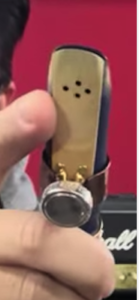

↑4個穴を開けたリードで吹くサックスから始まる
新時代のネックスクリューと葉っぱの試奏レビュー
Starting with a saxophone played on a reed with four holes drilled in the
Review of the amazing new generation of neck screws! Youtube
youtube転載本人許可済み
リードに穴を開けると吹きやすくなり、ハズレリードが復活するかも?
Drilling holes in the reeds will make it easier to blow, and may bring back the hazel reeds?
30年ほど前に、私が発明した『REED-UP』
About 30 years ago, I invented a product called “REED-UP,
Click here⇩⇩⇩
http://www.kit.hi-ho.ne.jp/suenaga/
https://suzzyy.net/wp-content/uploads/2023/01/reedup-1.pdf
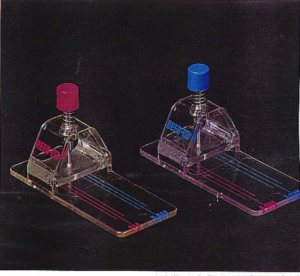 という商品で、
という商品で、
リードに穴を開けると出す音が楽になり、ダメリードが復活するかも?
というものでしたが、このアイテムは現在販売されていません。
しかしこの評判が良ければ再販されるかも???
これは当時、アメリカでク◯ト◯大統領さんが当選した時期で、
この人はテナーサックスを吹かれるということで、この『REED-UP』を
彼に贈りました。その時の返事文章です。

そしてこのリードに穴を開ける『REED-UP』を、
ジャズクラリネット奏者の北◯英◯さんが演奏に来られた時に
紹介したところ、
良くここまでの形にしたね、、と評価して頂きました。
今回 youtubeで『REED-UP』という道具で、リードに穴を開けて
アルトサックスで試奏することになりました。
右側が私で、左側がプロサックス奏者の三木先生です。
10:15〜からリードに1個から4個穴を開けて実際に吹いていただきました。
It was a product called “REED-UP”, which was invented by me about 30 years ago. This item is no longer on the market. However, if this item is well-received, it may be re-released?
This was the time when President Clinton was elected in the U.S., and this person plays tenor saxophone, so I gave him this “REED-UP” as a gift. Here is the text of his reply.
When jazz clarinetist Eiji Kitamura came to perform with us, we introduced him to the “REED-UP,” which opens a hole in the reed, and he commented, “You did a great job of making it look this good.
This time, I decided to try it on an alto saxophone with a hole drilled in the reed by “REED-UP” on youtube.
On the right side is me and on the left side is Dr. Miki, a professional saxophone player.
From 10:15~ we drilled one to four holes in the reed and actually played it.
Click here for English subtitles You-tube
youtube転載本人許可済み
昔販売されていたこのREEDUPの在庫が製造元会社の倉庫で残っているのを偶然発見!!
ご興味のある方はSax奏者三木俊彦さんの販売ページへどうぞ。 数に限りがあります。
Comparative measurement of reed vibration and waveform distribution with soprano saxophone
今回はソプラノサックスでノーマルネックスクリューと、
◯◯◯ブースターネックスクリュー及び、
◯◯◯ブースターより少し重さの少ない制振合金製ネックスクリュー
との比較をします。
In this article, we will compare a soprano saxophone with a normal neck screw, a ◯◯◯◯◯ booster neck screw, and a vibration-damping alloy neck screw that weighs slightly less than the Yanny booster.
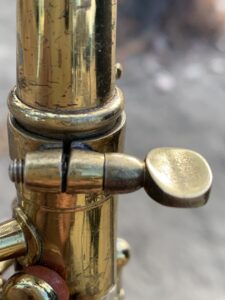

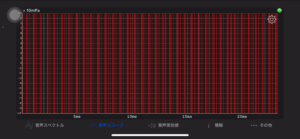
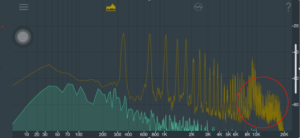
ソプラノサックスをノーマルネックスクリューで下のGの音で測定した。
リガチャーネジもノーマル
The soprano saxophone was measured on a normal neck screw with a lower G tone. Ligature screw is also normal
次に16.4gの◯◯◯ブースター で下のGの音で測定した。
Next, a 16.4g ◯◯◯◯◯ booster was used to measure the lower G tone.
Ligature screw is normal

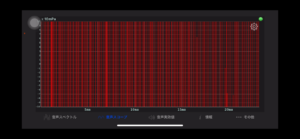
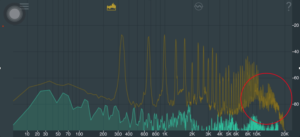
次は15.8gの制振合金製 で下のGの音で測定した。
The next one was made of a 15.8 g vibration-damping alloy and measured with the sound of G below.
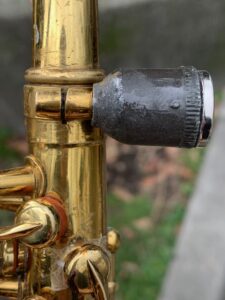
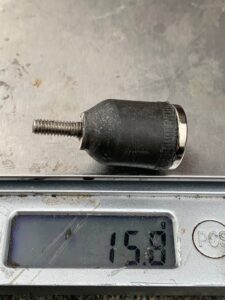
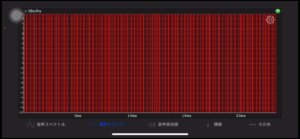
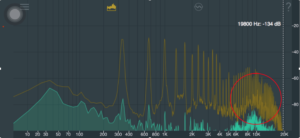
下の測定図は上から下へ、ノーマルネックスクリュー、◯◯◯ブースターネックスクリュー、15.8gの制振合金製ネックスクリューの順で、赤い縦線グラフは1/20秒間でのリード振動数を表しています。この縦線を左から20の所まで計算して、50倍すれば1秒間のリード振動がわかります。因みに、ノーマルでは1秒間/6250回で、◯◯◯ブースターでは1秒間/8000回、15.8gの制振合金製では1秒間/12000回でした。この値は、マウスピース、リード、リガチャーなどが変わるとこの数値も多少変化があります。
The measurement chart below shows, from top to bottom, the normal neck screw, the Yanny booster neck screw, and the 15.8 g damping alloy neck screw, in that order. The red vertical line graph shows the lead vibration frequency in 1/20th of a second. Calculate this vertical line from the left to the 20th place and multiply by 50 to get the lead vibration per second. For reference, the normal reeds vibrate 6250 times per second, the Yanny Booster reeds vibrate 8000 times per second, and the 15.8g damping alloy reeds vibrate 12000 times per second. These values will change slightly as mouthpieces, reeds, ligatures, etc. are changed.
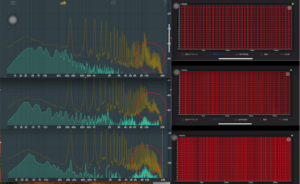
左の振動周波数分布グラフと、右の1/20秒間に振動する周波数を見て
全部同じ音程で音を出していながら右の比較グラフで縦線の違いがあることに、
これを見ているみなさんは気づきましたか?
周波数は、低い音程ではゆっくりと振動して縦線と縦線の間が広く
高い音程では振動が早くなって、縦線と縦線の間が狭くなるのが常識でした。
しかし今回、同じ音程で音を出しているのに、
縦線の周波数の幅が違うということは
リードの振動数が変化したと考えられ、上記グラフのような結果になったわけで
実際、今までよりリードの振動数が増えたことで音の変化や、
楽器の振動が増えたことを
演奏者が一番肌で感じています
この感覚は、例えば50ccエンジンのオートバイが、ワンタッチで
100ccのエンジンや150ccのエンジンに簡単に変身するようなもので、
この150ccのエンジンに変身したオートバイに乗った後に
元の50ccエンジンに戻ると、
全てのパフォーマンスに物足らなく感じるのと似ています。
しかし、この50ccエンジンのパフォーマンスはサックスという楽器が誕生して
以来今まで、素晴らしい良い音として長く聞き慣れた音でした。しかし
本発明の音は、今まで皆さんが経験したことが無い吹奏感であるためこの音を
体現すると、ノーマルにはハッキリと言って戻れないのでは無いでしょうか?
そしてもう一つの特徴は、
楽器から出る音を自分の手で好みの音質に出来ることです。
また、この写真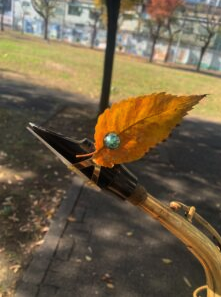 のように本発明のリガチャースクリュー磁石部分
のように本発明のリガチャースクリュー磁石部分
に、葉っぱを付け、ネックスクリューにも本発明のネックスクリューを使用する
と、音がすごく大きくなります。
その状態でベルの中にタオルを入れ音を出した場合、
当然音が小さくなりますが、
吹奏感はノーマル状態で音を出している時の息の量と同じくらいです。
これを弱く小さい音で吹奏しても、音程がしっかり出ているので、
防音設備のない室内で練習するには周りに迷惑をかけず、
音量的に大丈夫だと思います。
Look at the vibration frequency distribution graph on the left and the frequencies that vibrate in 1/20th of a second on the right.
The fact that all the notes are at the same pitch, but there is a difference in the vertical line in the comparison graph on the right,
Did you notice this, everyone looking at this?
At lower pitches, the frequencies vibrate more slowly and the space between the vertical lines is wider, while at higher pitches they vibrate more quickly and the space between the vertical lines is wider.
It was common knowledge that at higher pitches, the vibration is faster and the space between the vertical lines is narrower.
However, the fact that the width of the vertical line frequency was different even though the notes were played at the same pitch this time suggests that the reed’s frequency has changed, resulting in the results shown in the graph above.
In fact, the increase in the frequency of the reeds’ vibrations can be attributed to a change in the sound, or to an increase in the vibrations of the instrument,
In fact, the performer can feel firsthand that the vibrations of the instrument have increased due to the increased frequency of the reeds.
This feeling is similar to that of a motorcycle with a 50cc engine that can be converted to a 100cc engine or 150cc engine with a single touch.
It is similar to riding a motorcycle with a 150cc engine and then going back to the original 50cc engine and feeling that all the performance is not good enough.
However, the performance of the 50cc engine has long been familiar as a great sound since the birth of the saxophone instrument.
However, the sound of this new invention is similar to the sound that everyone has experienced until now.
The sound of this invention is a sound that you have never experienced before, and once you experience this sound, it is hard to go back to the normal sound.
And another feature,
It is that you can make the sound coming out of the instrument to your preferred sound quality by yourself.
Also, as shown in this picture, the ligature screw magnet part of the invention
and the neck screw of this invention, the sound will be very loud.
If you put a towel in the bell and make a sound,
the sound will naturally become quieter,
The sound is about the same as the volume of breath when the bell is played in the normal state.
Even if this is played weakly and at a low pitch, the pitch is still firm, so it is safe to practice indoors without soundproofing without disturbing the surroundings and without disturbing the volume.
最後に、55.3gの重いネックスクリューでどうなるか?と測定して見ました。
これは元々、ステンレス製作業台の4隅にある高さ調節用のネジで、
ネジ径が太かったのを直径4mmに削り、タップでネジを切ったものです。
すごく良い結果が出ると期待していましたが、
以外な結果が!
Finally, what happens with a heavier 55.3 g neck screw? I measured and saw. This was originally a height adjustment screw on the four corners of a stainless steel workbench. The screw diameter was thick, so it was cut down to 4 mm in diameter and threaded with a tap.
I was expecting very good results,
But the result was not what I expected!
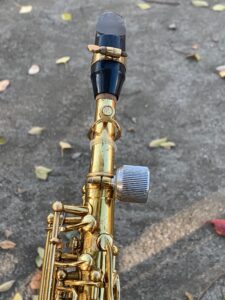
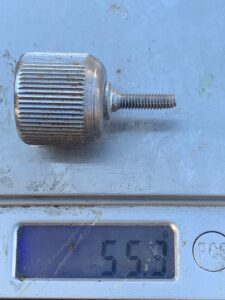
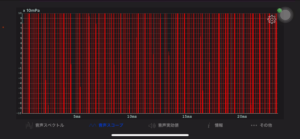
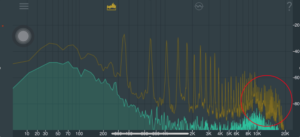
この重いネックスクリューは、楽器が重くなるだけでノーマルと比較してもあまり変わらなく、これは使えない。
This heavy neck screw is not useful because it only makes the instrument heavier and not much different compared to normal.
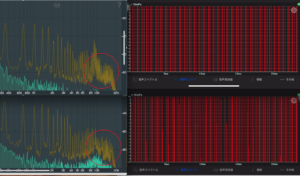
上記の◯◯◯ブースターではリード振動が約1,3倍に増え、これと重量が同じくらいの制振合金製ネックスクリューでは、リード振動が約1,9倍に増えます。制振合金製では低音部での音が全くひっくり返ることなく、今吹いているマウスピース、リガチャーなどのセッティングのままで全音が驚くほど出しやすくなるため、マウスピース、リガチャーなどの高級品を使用することなく練習が楽しみで仕方なくなります。もちろんお金を出して最高のマウスピース、リガチャーなどを使って今より良い音が出たとしても、そこに制振合金製ネックスクリューを付けるとそこからまだ音が良くなります。
With the ◯◯◯◯◯ booster mentioned above, reed vibration is increased about 1,3 times, and with a neck screw made of damping alloy, which weighs about the same as this one, reed vibration is increased about 1,9 times. With the damping alloy, the sound in the bass register is not turned over at all, and all notes are remarkably easier to produce with the same mouthpiece, ligature, and other settings you are currently playing, so you can look forward to practicing without having to use a high-end mouthpiece, ligature, or other expensive products. Of course, even if you pay for the best mouthpiece, ligature, etc. and get a better sound than you have now, you can put a damping alloy neck screw on it and the sound will still improve from there.
サックスやクラリネットの音が不思議に良くなるアイテム2つを紹介します。
Here are two items that will mysteriously improve the sound of your saxophone or clarinet.
葉っぱをリガチャーにつけます。 指輪をリガチャーにつけます。
Attach the leaves to the ligature. Attach the ring to the ligature.

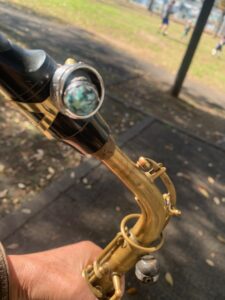
その前に基本になるアイテムの構成をお伝えします。
Before that, we will give you the basic composition of the items.
以下のアイテムを使用 Use the following items
⬇︎Damping alloy ligature screw ⬇︎Damping alloy weight plus magnet
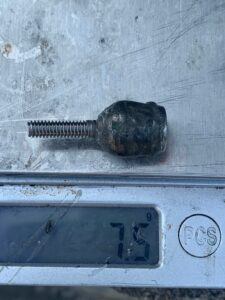
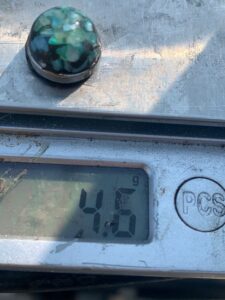
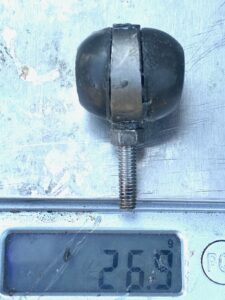
Damping alloy neck screw⬆︎

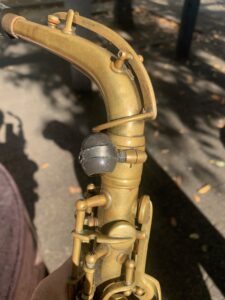
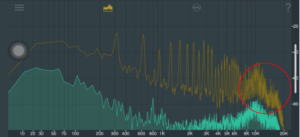
上のセッテングでの振幅周波数分布
Amplitude frequency distribution in the upper settee
上のセッテングでリガチャーネジの磁石の間に葉っぱを挟む
Put a leaf between the magnets of the ligature screws in the upper settee.
。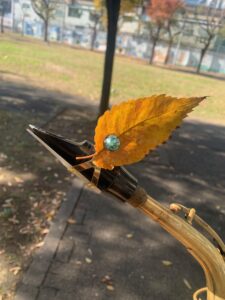
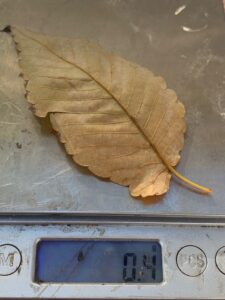
すると、出る音が〜 Then, the sound that comes out is…
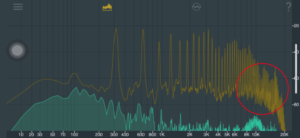
左元の音 右葉っぱを比較すると、 Compare left original sound right leaf,
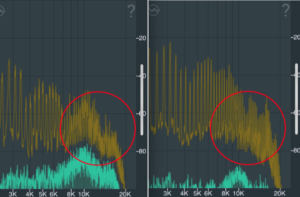
葉の種類や大きさ或いは乾燥具合によって音が変化する。
葉の代わりに羽根やクリックピン、アルミ箔、などを大きさを変えてつけても良い。
The sound varies depending on the type, size, and dryness of the leaves.
Instead of leaves, feathers, click pins, aluminum foil, etc. can be attached in different sizes.
ーーーーーーーーーーーーーーーーーーーーーーーーーーーーーー
次に リガチャー部分に指輪をはめる。
Next, fit the ring on the ligature part.
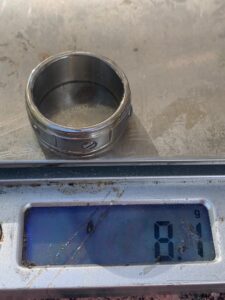
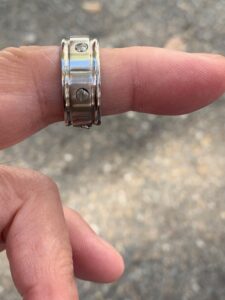
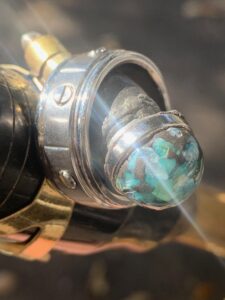
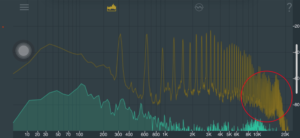
左元の音 右指輪を比較すると、 Left original sound Compare right ring,
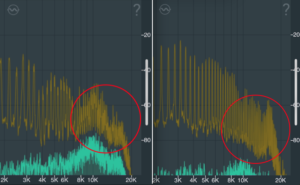
指輪をリガチャーにつけるだけで音の倍音がすごく増えて音がさらに良くなった。
Just by putting the ring on the ligature, the overtones of the sound increased so much and the sound became even better.
この指輪のメッキの種類や金属の純度、大きさによって、音の変化がある。
葉っぱや指輪を楽器に付けるなんて、
一見、奇想天外な発想だけど、実行して見てはいかがですか?
これでみんなの好みの音が出来そうかな?
これ以外にも音を良くするために、ここには書ききれないものが
たくさんあります。それはいずれ紹介します。
最後に、これを見て「葉っぱ」や「指輪」で何故、音が良くなるのか?
わかる人は連絡してください。
尚、これらのネジは試作品の段階で、販売はまだしていません
dampingalloy@gmaii.com
The type of plating on these rings, the purity of the metal, and the size of the ring can change the sound.
Attaching leaves and rings to a musical instrument may seem like a far-fetched idea, but why not try it out?
Would this create a sound to everyone’s liking?
There are many other things that can be done to improve the sound that cannot be described here. I will introduce them in due course.
Finally, why does this make “leaves” and “rings” sound better?
If you know, please contact me.
In case you are wondering, I live in Osaka City, Japan. Please contact me
These screws are in the prototype stage and are not yet available for sale.
dampingalloy@gmaii.com
New neck screw and ligature screw
ノーマル状態の音と、ネックスクリューとリガチャーネジと
磁石付きの制振合金製の錘を装着して
音の変化を振幅波形分布で比較しました。(特許出願中)
Sound in normal condition and with neck screw, ligature screw and The sound change was compared with the amplitude waveform distribution by attaching a damping alloy weight with a magnet. (Patent pending)
楽器: C.G.Conn マウスピース:VandorenA55
リード:Legere1,5 リガチャー:Selmer1本ネジ
ストラップ:B.AIR
ノーマルでの振幅波形分布
Amplitude waveform distribution in normal
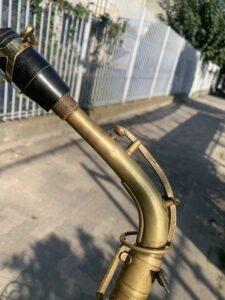
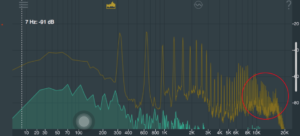
制振合金製ネックスクリューとリガチャーネジだけを使用
(使用品全て手造り試作品)
Only vibration-damping alloy neck screws and ligature screws are used
(All products used are handmade prototypes)
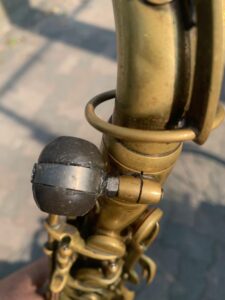

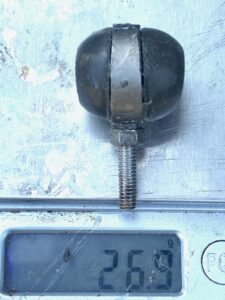

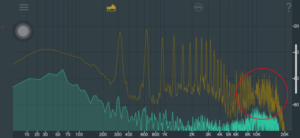
制振合金製ネックスクリューに、
磁石付きの制振合金製の錘を1個接着
For vibration-damping alloy neck screws ,
One damping alloy weight with magnet glued to
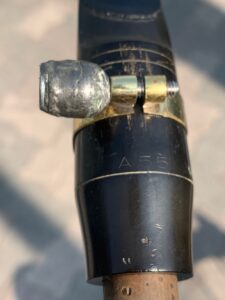
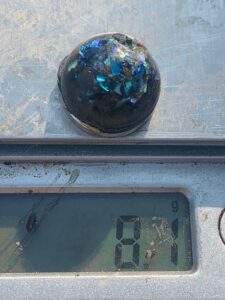
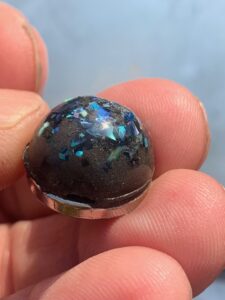
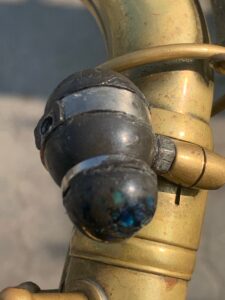

制振合金製ネックスクリューに、磁石付きの制振合金製の錘を2個装着
Vibration-damping alloy neck screw with two magnetic vibration-damping alloy weights
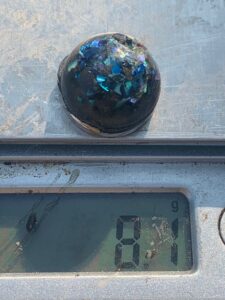


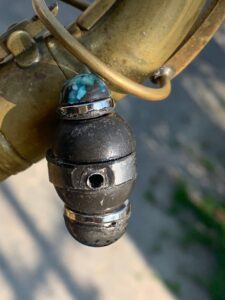
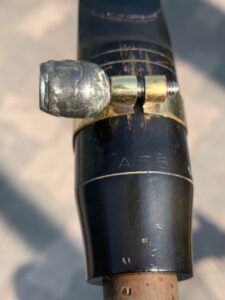
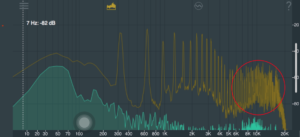
ーーーーーーーーーーーーーーーーーーーーーーーーーーーーーーーー
リガチャーの制振合金ネジに、制振合金雌ネジを付ける
ネックスクリューはノーマル
Damping alloy female threads on the ligature to the damping alloy screws
Neck screw is normal


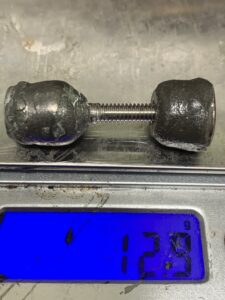

〜〜〜〜〜〜〜〜〜〜〜〜〜〜〜〜〜〜〜〜〜〜〜〜〜〜〜〜〜〜〜〜
ノーマルの上から下へ順に並べてみる
Normal in order from top to bottom
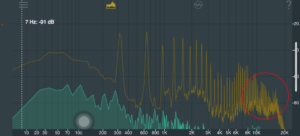
Normal ↑
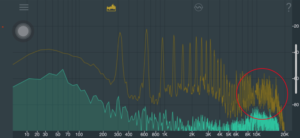
Only vibration-damping alloy ↑
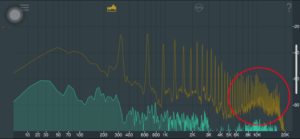
For vibration-damping alloy neck screws ,
One damping alloy weight with magnet glued to↑
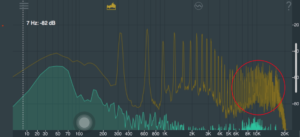
Vibration-damping alloy neck screw with two magnetic vibration-damping alloy weights↑

Damping alloy female threads on the ligature to the damping alloy screws
Neck screw is normal ↑
制振合金製ネックスクリューに、
色々な重さの違う磁石付きの制振合金製錘を装着することで
これを見ている人は、これで自分の好みの吹奏感を得られることが分かったと思う。
For vibration-damping alloy neck screws,
By attaching damping alloy weights with magnets of various weights.
I think anyone looking at this has found that this will give you the blowing feel you prefer.
最後にリガチャーネジに制振合金製雌ネジ錘を装着して計測した。ここに装着すると、ノーマルネックスクリューでも制振合金製ネジと同じように効果が大きい。
Finally, a vibration-damping alloy female threaded weight was attached to the ligature screw for measurement. When attached here, the effect is as great as that of the vibration-damping alloy screw, even with the normal neck screw.
次回はこれ以上に音が良くなる不思議な?アイテムを紹介します。
The next issue will be a wonder that makes the sound even better than this? I will introduce an item.
制振合金製のスクリューでリード振動が2倍以上になる方法
How a screw made of a vibration-damping alloy more than doubles the lead vibration
リガチャースクリューやネックスクリューをノーマルから
制振合金製のスクリューに交換するとリード振動が増える説明をします。
Explains how replacing ligature screws and neck screws from normal to vibration-damping alloy screws increases lead vibration
先ず、ノーマル状態のセッティングでは、
First, in the nomal state setting
下の図のように、リード振動によりマウスピースが共鳴振動します。
As shown in the figure below,reed vibration causes the mouthpiece to resonate and vibrate.
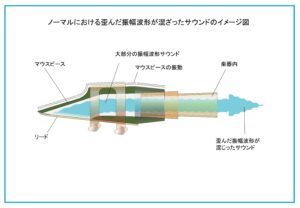
それに連れてマウスピースに繋がっているネック、バレル、楽器本体が同期して共鳴振動をします。
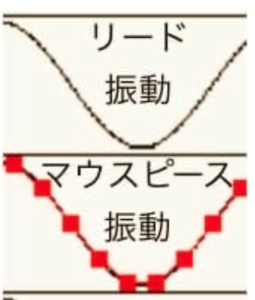
In turn, the neck, barrel, and body of the instrument connected to the mouthpiece vibrate in resonance in synchrony.
例えばこの状態は、薄い板を手に持って、
For example, this situation is like holding a thin board in your hand and sawing it!
この状態では、板が
In this state, it vibrates violently following the saw. The one who exerts the force is the saw and the one who receives the force is the board.
力を受ける方が力を出す方に追従して共鳴振動している状態では、

The one receiving the force is following the one exerting the force and vibrating in resonance. In this state, the saw cannot cut fast enough. It can cut faster by placing this board on a stand and holding it down with the hand.
力を受ける方の振動を抑えると力を出す方の能力が強くなるこの原理で
ノコギリの切る能力が上がる
This principle, in which the ability of the saw to cut is increased when the vibration of the one receiving the force is suppressed and the one exerting the force is strengthened, increases the saw’s ability to cut.
この原理と同じで、
The same principle applies to saxophones and clarinets: if the vibration of the mouthpiece, neck and barrel of the saxophone or clarinet is suppressed, the vibration of the reed will increase.
そこでサックスやクラリネットのリードを受ける方を抑えるために
To suppress the person receiving the saxophone or clarinet reed, a vibration-damping alloy screw is attached to the neck and ligature, which has the same effect of suppressing the vibration of the mouthpiece neck and barrel, thereby suppressing the board.

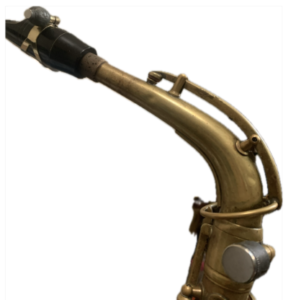
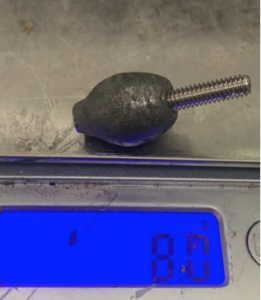
for ligature
the vibration-damping alloy screw 8g
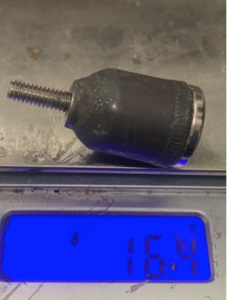 for neck the vibration-damping alloy screw 16.4g
for neck the vibration-damping alloy screw 16.4g
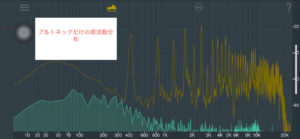
アルトサックスのネックだけで音を出した上の振幅波形分布↑
ノーマルネジ使用 KRK Audio Tolls アプリ使用 ↑
Amplitude waveform distribution when sound is produced only from the neck of the alto saxophone ↑ Normal screw used

アルトサックスのネックだけで音を出した上の振幅波形分布↑
8g制振合金ネジ使用 ![]() Using the KRK Audio Tools app ↑
Using the KRK Audio Tools app ↑
Amplitude waveform distribution when sound is produced using only the neck of the alto saxophone ↑ 8g Vibration-damping alloy screws used

制振合金性ネジの端に磁石をつけています。
楽器に初めからついているネジより音が良くなったうえ、
ここから自分の好みの吹奏感を、自分で色々選ぶことができます。
このことについては次回にお伝えします。
A magnet is attached to the end of the vibration-damping alloy screw.
The sound is better than the screws that are attached to the instrument from the beginning,
From here, you can choose various blowing sensations of your choice by yourself.
You can also choose the sound you want to hear.
We will tell you more about this in the next issue.
制振合金性のネジをつけることで音が大きくなり音がきれいになり
By adding a damping alloy screw, the sound becomes louder and cleaner, and the range from fortissimo to pianissimo becomes very wide.
今制振合金ネジの説明をしましたが、
I have just explained the vibration-damping alloy screw, and by changing to this vibration-damping alloy screw, the environment will return to the original vibration of the reed.
例えば、
For example, it can be said that you are running wearing athletic shoes with a raised heel. You can run fast and easy without any burden on your feet. You can perform in various ways without thinking. The same can be said for playing musical instruments such as saxophone, where the lead vibration has more than doubled.


それに比べノーマルネジではスリッパのようにした運動靴を
In contrast, with normal screws, you are running in athletic shoes that are probably made to look like slippers. You can’t run fast, and you have to constantly watch your feet. Since the creation of reed instruments, I have always heard the sound of a reed instrument in this state with the heel on the foot as a good sound.

今まで、本発明のようにマウスピース、ネック、バレルの共鳴振動を抑えると誰も音が数段良くなるとは思わなかった。 これについて共鳴振動を抑制すると楽器に伝わる振動が小さくなって全く良い音が出ないと考えられていた。そのためこのような非常識的な発想が出なかったと思われる。
Until now, no one thought that suppressing the resonant vibration of the mouthpiece, neck, and barrel, as in the present invention, would improve the sound by several orders of magnitude. It was thought that if resonance vibration was suppressed, the vibration transmitted to the instrument would be reduced and no good sound would be produced at all. It is believed that this is why such an insane idea did not emerge.
詳しい事はsuzzyy,netを見てください。
なおこの制振合金製ネジは特許申請中です。
ここまで興味を持って見てくれてありがとう
For more information, please see suzzyy.net This vibration-damping alloy screw is patent pending.
Thank you for your interest so far!